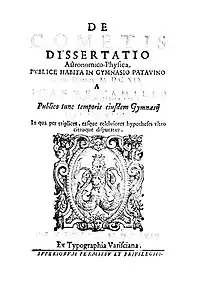Giovanni Camillo Glorioso
Giovanni Camillo Glorioso (or Gloriosi) (1572 – 8 January 1643) was an Italian mathematician and astronomer. He was a friend of Marino Ghetaldi and successor of Galileo Galilei in Pisa, then in Padua.
Giovanni Camillo Glorioso | |
|---|---|
| Born | 1572 |
| Died | 8 January 1643 (aged 70–71) |
| Nationality | Italian |
| Other names | C. Mallius Eudoxus |
| Occupation(s) | |
| Academic background | |
| Alma mater | University of Naples Federico II |
| Influences | |
| Academic work | |
| Discipline | Mathematician, physician, astronomer |
| Institutions | University of Padua |
| Notable students | Giovanni Francesco Sagredo[1] |
| Influenced | Giovanni Alfonso Borelli[1] |
| Signature | |
Life
Giovanni Camillo Glorioso was born in the village of Mercato or Santa Maria a Vico of Giffoni Valle Piana. He had a correspondence with Galileo Galilei in 1604 and he replaced him at the University of Padua, with an income of 350 florins per year, in 1613. He led observations on the 1618 comet, on Mars, and on some aspects of Saturn. He came closer to Antonio Santini (1577-1662) and he had contrasts with Scipione Chiaramonti and his successor at the university of Pisa, Barthélemy Souvey, student of Fortunio Liceti. Glorioso was particularly harsh in his attack on Scipione Chiaramonti's efforts to defend traditional Aristotelian cosmology. He criticised Chiaramonti's De tribus novis stellis and in 1636 Charamonti published a refutation, Examen censurae Gloriosi, to which Glorioso replied the following year Castigatio examinis. To this Chiaramonti responded in turn with Castigatio Ioannis Camilli Gloriosi aduersus Scipionem Claramontium Caesenatem (1638). Glorioso's final contribution to this dispute was his Responsio (1641). As he died soon after, this allowed Chiaramonti the last word, which he took with a volume of more than 500 pages, summarising his Aristotelian positions on a wide range of topics, his Opus Scipionis Claramontis Caesenatis de Universo (1644).[2]
Glorioso considered, following the theme of the parallax, that comets were in fact celestial bodies, against Galileo's opinion. In a 1610 letter to his friend Giovanni Terrenzio, he asserted that Galileo erroneously attributed the invention of the telescope and of the sector to himself, instead to Michel Coignet, accusations that appeared to be unfounded: Rosen (1954) shows that Galileo did not affirm to be the inventor of the telescope, which he called the "Dutch tube", but he considered himself as the inventor of its tools, and that was probably cause of confusion. The situation is the same for what concerns the sector, which, in its different forms, had several inventors.[3] It was excluded, for chronological reasons, that Coignet's tool could have inspired Galileo.[4]
One of his works took the title from the last work of Alexander Anderson, published in 1619 in Paris: Alexandri Andersoni Exercitationum Mathematicarum Decas Prima.[5] This work shows that Glorioso wrote his algebrical calculations in a language inherited from the algebra of Viète.[6] It's one of the first work to use the notation for the equivalent of the current .
He died in Naples in 1643.
Family
Glorioso had a brother, Alessandro, and a sister, Porzia. The properties inherited by the son of his brother Alessandro are in Santa Maria a Vico and in the Serroni di Sei casali. Giovanni Camillo had other relatives in Mercato di Giffoni Valle Piana, among which the Guardian of San Francesco's convent, brother Hieronimo de Glorioso.
Works

- Ad problema geometricum responsum. Baglioni, Tommaso. 1613.
- De cometis dissertatio astronomico-physica publice habita in gymnasio Patauino anno Domini 1619 (in Latin). Venezia: Giovanni Varisco & Varisco Varisco. 1624.
- Responsio ad apologiam Benedicti Maghetti (in Latin). Napoli: Secondino Roncagliolo. 1641.
- Responsio ad Scipionem Claramontium. 1641.
References
- Baldini 2001.
- Benzoni, Gino. "Chiaramonti Scipione". Dizionario Biografico degli Italiani. Treccani. Retrieved 29 September 2018.
- Roberto Vergara Caffarelli, 1992
- Ad Meskens, Michiel Coignet's contribution to the development of the sector, Annals of Science, volume 54, 2 mars 1997, pp. 143-160.
- Cajori :William Oughtred, a great seventeenth-century teacher of mathematics
- Joseph Frederick Scott : work of John Wallis, D.D., F.R.S., (1616-1703)
Further reading
- Baldini, Ugo (2001). "GLORIOSI, Giovanni Camillo". Dizionario Biografico degli Italiani, Volume 57: Giulini–Gonzaga (in Italian). Rome: Istituto dell'Enciclopedia Italiana. ISBN 978-8-81200032-6.
- M. Bernegger e B. Capra, Ed. ETS, 1992, pp. IX-XLI (d'après la page de l'auteur sur il Laboratorio di Galileo Galilei), lire en ligne, traduction anglaise Katiuscia Mariottini, (in English) lire en ligne.
- Roberto Vergara Caffarelli, Il compasso geometrico e militare di Galileo Galilei - Testi, annotazioni e disputa negli scritti di G. Galilei, 1992.
- Edward Rosen (1954). Did Galileo claim he invented the Telescope?. Vol. 98. Proceedings, American Philosophical Society. pp. 304–311. ISBN 9781422381250.
- Giuseppe Tesauro Falivene, Giovan Camillo Glorioso, Studio in dodici Tomi pp.3800 circa 2014-2020.
- Bockstaele, P.P. (1981). J.W. Dauben (ed.). "Adrianus Romanus and G.C. G. on isoperimetric figures". Mathematical Perspectives. New York: 1–11. ISBN 9781483262574.